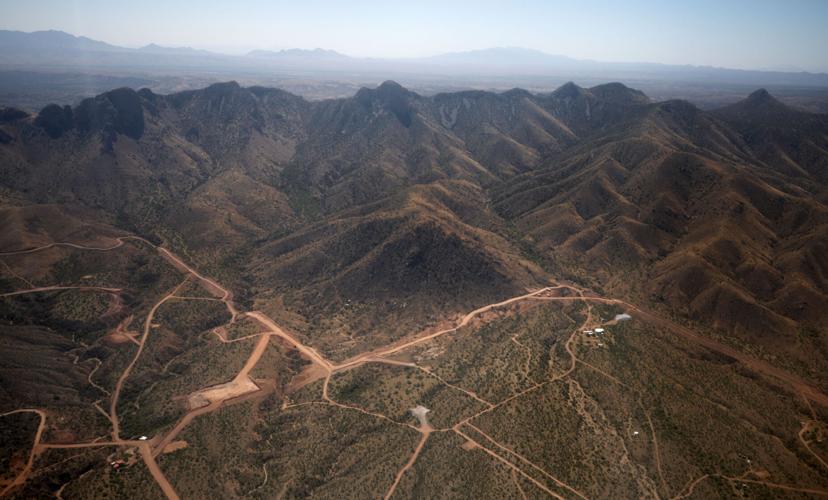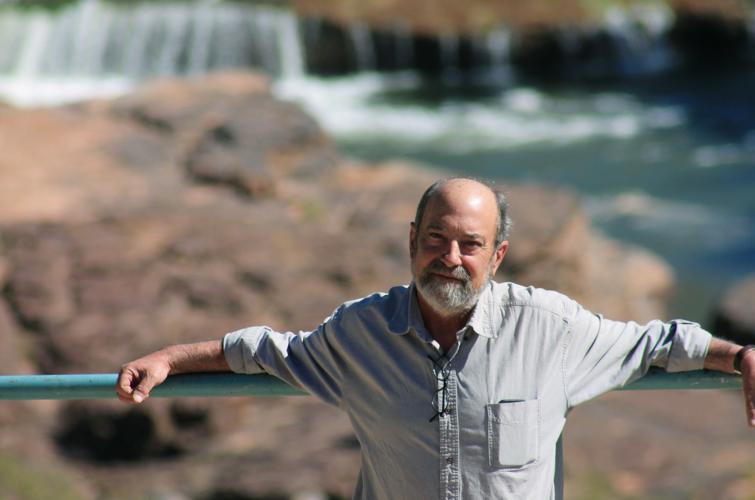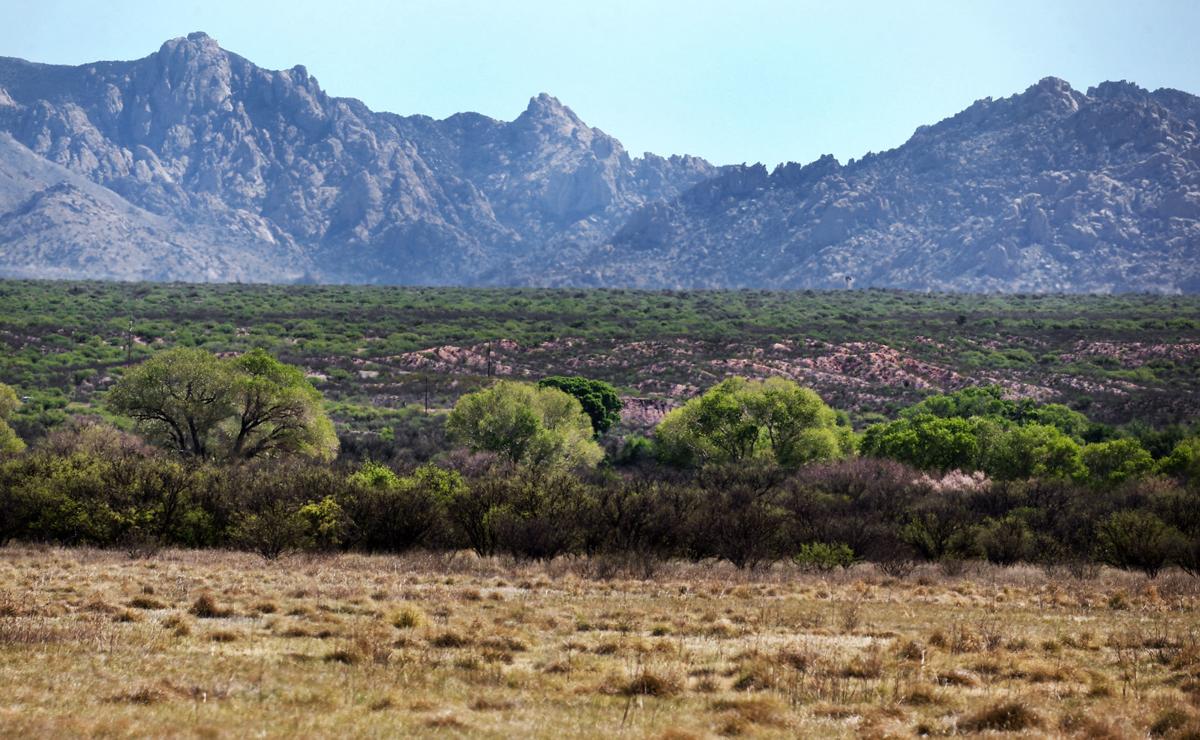A recent landmark U.S. Supreme Court ruling is likely to take a big bite out of the Clean Water Act’s reach in Arizona and the Southwest, particularly when it comes to regulating development along most of this state’s streams, many experts say.
The high court ruling will be a major victory for two major Southern Arizona projects that have been tied up at least in part by Clean Water Act issues for many years, according to a number of environmental law experts.
The Copper World copper mine project — an expanded version of the now-defunct Rosemont Mine proposal — in the Santa Rita Mountains southeast of Tucson.
The proposed 28,000-home Villages of Vigneto project lying a few miles west of the San Pedro River in Benson.
The ruling could also take the regulatory reins off many future such projects across the Southwest.
The Copper World and Vigneto projects have drawn significant federal attention, and at times very detailed federal permitting oversight, because they would be built amid a number of normally dry streambeds that have or could come under Clean Water Act jurisdiction.
But because of the Sackett vs. EPA ruling late last month, these projects could become free of Clean Water Act authority, making them easier to carry out.
Overall, the Sackett ruling signifies a major shift in how the federal government will enforce the Clean Water Act. It significantly reduces the scope of what’s covered as “waters of the U.S.” — streams, rivers and lakes that are deemed worthy of federal regulation and protection.
The ruling represents a major victory for property rights activists who say agencies enforcing the act have overstepped bounds on their authority placed by Congress when it passed the act in 1972. But environmentalists say the ruling will open the door to major environmental damage to rivers and streams and reverse more than four decades of how the Clean Water Act has been enforced here and nationally.
“For all practical purposes, Arizona is out of the Clean Water Act,” said Patrick Parenteau, a Vermont Law School professor who since 1975 has either taught courses on the Clean Water Act, administered it for the Environmental Protection Agency, or litigated over the act as a National Wildlife Federation attorney. “Your streams are mostly ephemeral. It’s incredibly serious.”
Ephemeral streams normally carry water only after storms. The decision will remove federal authority not only to issue permits for new developments alongside such streams, but to discharge pollutants into the streams, he said. This will mean more toxic discharges and spills into streams, “unless you can fill the gap with state regulations.”

Aerial view of the Santa Rita Mountains near the proposed Copper World project planned by Hudbay Minerals Inc. The flight was coordinated by the Center for Biological Diversity and carried out by EcoFlight. Hudbay is doing grading and land clearing on private lands it owns there and eventually plans four open pits. The site also includes roads that existed before Hudbay’s work started.
Parenteau and Craig Johnston, a law professor at Lewis and Clark College in Portland, Oregon, told the Arizona Daily Star this ruling will be a “disaster” for many streams and wetlands, including the Southwest’s normally dry streams.
But the Pacific Legal Foundation, a nonprofit, property rights group that argued the Sacketts’ case, said it’s up to the states, not the federal government, to insure that rivers and wetlands are adequately protected.
“This decision is a significant victory for private property rights and the separation of powers, and return of the Clean Water Act to how Congress authorized it back in 1972,” said Charles Yates, a foundation attorney who served on a team of attorneys who represented the Sacketts before the Supreme Court.
“What the Supreme Court has done here is recognized the limitation that Congress placed on the agencies’ authority,” Yates said. “The act was passed ostensibly to fight water pollution, but what it has done is create a permitting regime.”
Typically, Congress passes legislation and gives federal agencies discretion to implement and enforce the laws, “but when Congress does that, it has to place a guardrail on the agencies in the executive branch,” he said. “They have no authority to set policy.”
Five law profs agree on AZ impacts
At first glance, the Sackett ruling appears to apply mainly to wetlands, which are rare in Arizona. The ruling dealt with an Idaho case in which a married couple was challenging an EPA decision that they needed a Clean Water Act permit to build a home because it lies on a wetland near a ditch that feeds a creek, which empties into a nearby lake.
Because of the wetland issue, construction of the Sacketts’ project had been delayed since the mid-2000s.
While all nine justices agreed with the Sacketts that their project should not have been covered by the act, a 5-4 majority opinion carried that conclusion a big step farther. Justice Samuel Alito’s opinion said that for a wetland to be covered by the Clean Water Act, it had to either abut another federally regulated water body or have a “continuous surface connection” to such a water course or lake.
Alito held that all waters of the U.S. must be “relatively permanent,” a term for which no formal legal definition exists, and that they be connected to a navigable waterway of some sort.
While Alito didn’t mention the kind of streams that dominate Arizona — ephemeral streams that flow only after rains — five law professors contacted by the Star agreed it will end or severely crimp any federal regulation of development along such streams.
Both the Copper World and Vigneto projects include several ephemeral streams within their boundaries.
Some experts also see potential for the ruling to limit federal oversight of development along intermittent streams, which run part of the year and aren’t tied directly to immediate storm activity.
At a U.S. House committee hearing on Thursday, June 22, Assistant Secretary of the Army Michael Connor testified that the U.S. Army Corps of Engineers and the EPA will come up with a new rule governing Clean Water Act regulation and enforcement “expeditiously.” Under extensive questioning by House Republicans, Connor declined to specify how the new rule would treat wetlands or streams.
But he said it will be different from the existing rule, which offers legal protection of both ephemeral and intermittent streams under certain circumstances. There will be “specific aspects” of the current rule that no longer will be valid, given the court ruling, he said.
And until the agencies come up with a revised rule, they will no longer even try to determine if a wetland or a stream targeted for a proposed development is legally worthy of federal regulation, he testified. What are called “approved jurisdictional determinations” will be put on hold for now.
Narrowing of protections
Until now, the federal agencies have largely based decisions on when a stream or wetland is a “water of the U.S.” on another Supreme Court decision in 2006.
In that decision, Rapanos vs. the United States, the court split 4-4-1 over what kinds of waters should be covered by the Clean Water Act. Four justices argued that ephemeral streams and some wetlands deserve no federal protection, while four others concluded most do deserve it.
The ninth justice, Anthony Kennedy, argued for a test of whether a wetland in question had a “significant nexus,” or connection, with a navigable waterway. EPA and the Army Corps of Engineers have used that definition since then to determine if a waterway is regulated under the act.
But in the Sackett decision, all nine justices agreed the Kennedy definition was not valid and shouldn’t be used.
While Alito’s opinion didn’t mention ephemeral streams by name, many experts say it rules out declaring any such streams as “waters of the U.S.”
One reason is that Alito said “waters of the U.S.” must be relatively permanent and ephemeral streams aren’t relatively permanent, Parenteau said. While Alito’s ruling didn’t define the term, Alito and the other four justices who supported him essentially adopted a narrow waters of the U.S. definition laid down in the 2006 ruling by then-Justice Antonin Scalia, he said.
Scalia wrote that “waters of the U.S. doesn’t include channels through which water flows intermittently or ephemerally, or channels that periodically provide drainage for rainfall.”
“Scalia was specific. He didn’t want ephemeral streams to be covered. This (Sackett) opinion doesn’t discuss that issue with any specificity, but (the justices who supported it) do bow at the altar of Justice Scalia,” said Johnston, the Lewis and Clark professor.
An attorney who still holds out hope that ephemeral streams could be covered in some cases is Stu Gillespie, of the environmental law firm Earthjustice. He represents three tribes that have sued to block Hudbay Minerals Inc.’s Rosemont and Copper World projects and four environmental groups that have sued to block the Villages at Vigneto.
“There is a lot of room here to make the case that ephemeral streams on a case-by-case basis are covered by the Clean Water Act,” Gillespie said. “They are relatively permanent, defined features on the landscape. They convey thundering torrents of water in flood events and storm events. That sometimes happens multiple times each year.”
Intermittent streams could fare better under the Sackett ruling, several experts said. That’s in part because Scalia’s opinion in the 2006 Rapanos case contains a footnote that makes it clear the late justice was not wholly opposed to having intermittent streams covered, Gillespie said.
Scalia wrote, “We have no occasion in this litigation to decide exactly when the drying up of a streambed is continuous and frequent enough to disqualify the channel as a ‘water of the United States.’”
But intermittent streams’ status is now in doubt because of the Sackett ruling’s requirements for streams to be relatively permanent and connected to a navigable waterway to qualify as “waters of the U.S.,” Parenteau said.
“That is the first time any opinion has ever used that terminology, and it is sure to be seized on by opponents of Clean Water Act jurisdiction to further narrow whatever intermittent streams are covered,” he said.
Case Western Reserve University law professor Jonathan Adler, who is more conservative and skeptical of regulations than a lot of other environmental law professors, said he believes many intermittent streams won’t carry enough water to establish Clean Water Act jurisdiction, “certainly not over projects for economic development” as opposed to those with polluting discharges.
“If we’re talking about traditional pollution, it depends on how easy or difficult it is for EPA to demonstrate the connection” between an intermittent stream and a navigable waterway, Adler said.
For a development that would discharge clean fill into an intermittent stream, that’s “where this decision will have a pretty significant impact,” he said. “Fill” is dirt put into a stream so it can be built on.
‘I would be very sad for the San Pedro’

Steve Spangle, former head of U.S. Fish and Wildlife Service’s Arizona office, says if the proposed Vigneto development isn’t regulated under the Clean Water Act, “I would be absolutely crushed for the San Pedro” River.
The Rosemont Mine’s washes were at various times determined by the Army Corps to be covered and then not covered by the Clean Water Act. The most recent decision, in summer 2020, concluded they weren’t covered.
The Copper World project, which includes the entire Rosemont site on the Santa Ritas’ east slope and much more land on the range’s west slope, has never been formally determined to be either covered or not covered by the Clean Water Act. Gillespie has tried to get the Army Corps and the EPA to decide that they were covered, but neither agency had made a decision by the time of the Sackett ruling.
The Army Corps has said since the mid-2000s the Vigneto project is covered under the Clean Water Act. The Corps has issued, suspended, reissued and re-suspended a Clean Water Act permit authorizing Vigneto’s construction. That suspension remains in effect.
Officials of Hudbay, which proposes to build Copper World, and of El Dorado Holdings Inc., which proposes to build Vigneto, didn’t return calls from the Star seeking comment on the court’s Sackett ruling.
But if Vigneto isn’t regulated under the Clean Water Act, that could leave it free to dry up the neighboring San Pedro River with its groundwater pumping, environmentalists say.
If that happens, “I would be very sad for the San Pedro — I would be absolutely crushed for the San Pedro,” said former U.S. Fish and Wildlife Service Arizona field supervisor Steve Spangle. He alleged four years ago, after his retirement, that he was forced by political pressure from federal higher-ups to back off his previously tough stance on the Vigneto project. Top Interior Department officials said they were only following the law in pushing Spangle to change his stance.
“That project is going to use a hell of a lot of water, and I would absolutely assume there will be an impact” on the San Pedro, Spangle said. “They never told us where they would get the water, but the only water available is groundwater.”

The proposed Vigneto development is near the San Pedro River, shown above.
In general, if ephemeral streams aren’t covered by the Clean Water Act, “people will build stuff along them that otherwise, they would not have built,” and the most direct impacts on Arizona will be flooding, said David Owen, a law professor at UC College of Law in San Francisco.
“If you’re building something in an ephemeral streambed, even if it doesn’t have water most of the time, it is going to flood, sometimes catastrophically,” Owen said. “This will give developers and builders a free hand to build in dangerous places.”
Water quality in these streams when they do carry water could also suffer, he said. If washes are filled in with sediment or any materials carrying pollutants, that will hurt water quality. Another threat will be the loading of phosphorous, nitrogen and other nutrients into streams from agricultural runoff, he said. The nutrients can generate toxic algae blooms that can make water undrinkable, he said.
But at the same time, Arizona has many tools besides the Clean Water Act to protect public health and the environment, said Caroline Oppleman, an Arizona Department of Environmental Quality spokeswoman. One is the state Surface Water Protection Program, which authorizes ADEQ to protect waters not regulated by the Clean Water Act, she said.
Federal hazardous waste laws, the state’s Aquifer Protection Program and solid waste regulations also can be used to protect water quality in streams left uncovered by the Clean Water Act, Oppleman said.
And while state law generally forbids state environmental rules from being stricter than federal rules, the Legislature has on occasion authorized the agency to adopt stronger regulations than federal laws require, she said. One example is that state law authorized ADEQ to develop a Surface Water Protection Program for streams not covered by the Clean Water Act.
“As ADEQ learns more about how the Sackett case affects (Clean Water Act) regulation, ADEQ will work with state leadership to ensure Arizona’s waters continue to be protected,” Oppleman said
Just because water features are no longer regulated under the Clean Water Act doesn’t mean they won’t be regulated at all, said Yates, of the Pacific Legal Foundation.
“The states have primary authority in regulating land and water use. It’s not a power the federal government possesses,” he said. An objective of the Clean Water Act was to preserve states’ traditional power in land and water use, “and the Supreme Court has brought some discipline to the way the act is implemented,” he said.
But as far as Tucson environmentalist Christina McVie is concerned, Arizona has nothing on the books today to replace the Clean Water Act when it comes to regulating development.
For instance, Oro Valley town officials and the state Land Department have long talked and planned of building a major development in an area called Arroyo Grande, a huge swath of state land along North Oracle Road lying just north of the town’s current boundary.
“Let’s say that development were to go forward. Without Clean Water Act guidance, that could be real problematic,” McVie said. “There are so many tributaries into the Big Wash in that area, that’s a tricky wicket for developing.” With longstanding Clean Water Act regulation now overturned, “it’s incumbent on the state and local governments to pick up the slack,” she said.
Homebuilders say few projects affected
For development overall in Southern Arizona, the Sackett decision will obviously have some meaningful impacts, but “there’s still a long way to go” before they become clear, said David Godlewski, president of the Southern Arizona Home Builders Association.
Almost every project built in Southern Arizona has to at least take Section 404 of the Clean Water Act — which requires federal permits for projects along regulated streams — into consideration, he said.
But while some developers complain about higher costs and significant delays due to Clean Water Act permitting requirements, typically, at most two or three projects a year in this area have enough impact on waterways to require a detailed Clean Water Act permit that assesses their environmental impacts, he said.
The rest can operate under much less strict “nationwide” permits, which don’t require a detailed analysis of individual projects.
While the Sackett ruling clearly eliminates the “significant nexus” test, “there’s also this question: Is it only applicable to wetlands? Or does it apply to ephemeral and intermittent streams?” Godlewski said.
“Our potential take is that it does affect federal jurisdiction of waterways here,” he said. “But it is premature. We still have to wait for sure.”
The river's beaver population is hanging on almost 25 years after being reintroduced by wildlife officials.








